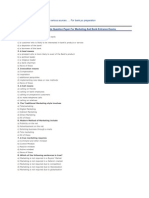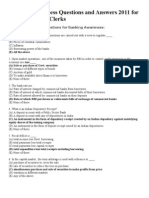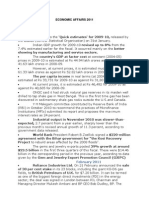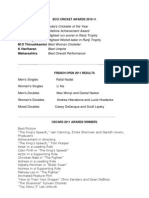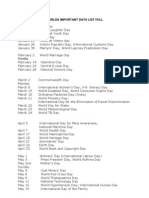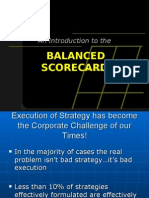General Socio-Economic & Banking Awareness
General Socio-Economic & Banking Awareness
Uploaded by
Kapil MalikCopyright:
Available Formats
General Socio-Economic & Banking Awareness
General Socio-Economic & Banking Awareness
Uploaded by
Kapil MalikOriginal Title
Copyright
Available Formats
Share this document
Did you find this document useful?
Is this content inappropriate?
Copyright:
Available Formats
General Socio-Economic & Banking Awareness
General Socio-Economic & Banking Awareness
Uploaded by
Kapil MalikCopyright:
Available Formats
GENERAL SOCIO-ECONOMIC & BANKING AWARENESS
General Socio-Economic & Banking Awareness : 1. RBIs open market operation transactions are carried out with a view to regulate (A) Liquidity in the economy (B) Prices of essential commodities (C) Inflation (D) Borrowing power of the banks (E) All the above 2. When more than one banks are allowing credit facilities to one party in coordination with each other under a formal arrangement, the arrangement is generally known as (A) Participation (B) Consortium (C) Syndication (D) Multiple banking (E) None of these 3. Open market operations, one of the measures taken by RBI in order to control credit expansion in the economy means (A) Sale or purchase of Govt. securities (B) Issuance of different types of bonds (C) Auction of gold (D) To make available direct finance to borrowers (E) None of these 4. The bank rate means (A) Rate of interest charged by commercial banks from borrowers (B) Rate of interest at which commercial banks discounted bills of their borrowers (C) Rate of interest allowed by commercial banks on their deposits (D) Rate at which RBI purchases or rediscounts bills of exchange of commercial banks (E) None of these 5. What is an Indian Depository Receipt ? (A) A deposit account with a Public Sector Bank (B) A depository account with any of Depositories in India (C) An instrument in the form of depository receipt created by an Indian depository against underlying equity shares of the issuing company (D) An instrument in the form of deposit receipt issued by Indian depositories (E) None of these 6. An instrument that derives its value from a specified underlying (currency, gold, stocks etc.) is known as (A) Derivative (B) Securitisation Receipts (C) Hedge Fund (D) Factoring (E) Venture Capital Funding 7. Fiscal deficit is (A) total income less Govt. borrowing (B) total payments less total receipts (C) total payments less capital receipts (D) total expenditure less total receipts excluding borrowing (E) None of these 8. In the Capital Market, the term arbitrage is used with reference to (A) purchase of securities to cover the sale (B) sale of securities to reduce the loss on purchase (C) simultaneous purchase and sale of securities to make profits from price
(D) variation in different markets (E) Any of the above 9. Reverse repo means (A) Injecting liquidity by the Central Bank of a country through purchase of Govt. securities (B) Absorption of liquidity from the market by sale of Govt. securities (C) Balancing liquidity with a view to enhancing economic growth rate (D) Improving the position of availability of the securities in the market (E) Any of the above 10. The stance of RBI monetary policy is (A) inflation control with adequate liquidity for growth (B) improving credit quality of the Banks (C) strengthening credit delivery mechanism (D) supporting investment demand in the economy (E) Any of the above 11. Currency Swap is an instrument to manage (A) Currency risk (B) interest rate risk (C) currency and interest rate risk (D) cash flows in different currencies (E) All of the above 12. Sub-prime refers to (A) lending done by banks at rates below PLR (B) funds raised by the banks at sub-Libor rates (C) Group of banks which are not rated as prime banks as per Bankers Almanac (D) lending done by financing institutions including banks to customers not meeting with normally required credit appraisal standards (E) All of the above 13. Euro Bond is an instrument (A) issued in the European market (B) issued in Euro Currency (C) issued in a country other than the country of the currency of the Bond (D) All of the above (E) None of these Bank of Baroda po exam papers question 14 to 25 14. Money Laundering normally involves (A) placement of funds (B) layering of funds (C) integration of funds (D) All of (A), (B) and (C) (E) None of (A), (B) and (C) 15. The IMF and the World Bank were conceived as institutions to (A) strengthen international economic co-operation and to help create a more stable and prosperous global economy (B) IMF promotes international monetary cooperation (C) The World Bank promotes long term economic development and poverty reduction (D) All of (A), (B) and (C) (E) None of (A), (B) and (C) 16. Capital Market Regulator is (A) RBI (B) IRDA (C) NSE (D) BSE (E) SEBI 17. In the term BRIC, R stands for (A) Romania
(B) Rajithan (C) Russia (D) Regulation (E) None of these 18. FDI refers to (A) Fixed Deposit Interest (B) Fixed Deposit Investment (C) Foreign Direct Investment (D) Future Derivative Investment (E) None of these 19. What is Call Money ? (A) Money borrowed or lent for a day or over night (B) Money borrowed for more than one day but upto 3 days (C) Money borrowed for more than one day but upto 7 days (D) Money borrowed for more than one day but upto 14 days (E) None of these 20. Which is the first Indian company to be listed in NASDAQ ? (A) Reliance (B) TCS (C) HCL (D) Infosys (E) None of these 21. Which of the following is the Regulator of the credit rating agencies in India ? (A) RBI (B) SBI (C) SIDBI (D) SEBI (E) None of these 22. Who is Brand Endorsing Personality of Bank of Baroda ? (A) Juhi Chawla (B) Kiran Bedi (C) Amitabh Bachchan (D) Kapil Dev (E) None of these 23. The branding line of Bank of Baroda is (A) International Bank of India (B) Indias International Bank (C) Indias Multinational Bank (D) Worlds local Bank (E) None of these 24. The logo of Bank of Baroda is known as (A) Sun of Bank of Baroda (B) Baroda Sun (C) Bank of Barodas Rays (D) Sunlight of Bank of Baroda (E) None of these 25. Which of the following statements(s) is/are True about the exports of China which is a close competitor of India ? (i) Chinas economic success is basically on the fact that it exports cheaper goods to rich nations like the USA, etc. (ii) In the year 2007 Chinas exports became almost 40% of its GDP. (iii) When compared to India Chinas share in the World Exports is more than 30% whereas Indias share is mere 6% of the global exports. (A) Only (i)
(B) Only (ii) (C) Both (i) and (ii) (D) All (i), (ii) and (iii) (E) None of these 1. (E) 2. (B) 3. (A) 4. (D) 5. (C) 6. (C) 7. (D) 8. (C) 9. (A) 10. (E) 11. (D) 12. (D) 13. (C) 14. (D) 15. (D) 16. (E) 17. (C) 18. (C) 19. (A) 20. (D) 21. (D) 22. (E) 23. (B) 24. (B) 25. (C) .................................................................................................................................................................. ........
You might also like
- SIE Exam Practice Question Workbook: Seven Full-Length Practice Exams (2024 Edition)From EverandSIE Exam Practice Question Workbook: Seven Full-Length Practice Exams (2024 Edition)Rating: 5 out of 5 stars5/5 (1)
- " Analysis of Customer Lifetime Value & It's Impact On Business Strategy (ZARA)Document77 pages" Analysis of Customer Lifetime Value & It's Impact On Business Strategy (ZARA)Mayank Pal100% (1)
- Business and Marketing Analysis and Suggestions To A Newly Proposed Apartment Project in Sri LankaDocument14 pagesBusiness and Marketing Analysis and Suggestions To A Newly Proposed Apartment Project in Sri LankaSithari RanawakaNo ratings yet
- Balanced Scorecard Air Asia Airline IndustryDocument3 pagesBalanced Scorecard Air Asia Airline IndustryVidal De Arce RodriguezNo ratings yet
- JANBI Model Questions - Principles & Practices of Banking - 0Document8 pagesJANBI Model Questions - Principles & Practices of Banking - 0Biswajit Das0% (1)
- 9A0 384 Q&A Demo CertMagicDocument16 pages9A0 384 Q&A Demo CertMagicpaka madhuriNo ratings yet
- Questions AnswersDocument30 pagesQuestions AnswersIndupal SinghNo ratings yet
- Bank of Baroda Probationary Officers Exam., 2008 (Held On 5-10-2008) General Socio-Economic and Banking Awareness: Solved PaperDocument9 pagesBank of Baroda Probationary Officers Exam., 2008 (Held On 5-10-2008) General Socio-Economic and Banking Awareness: Solved PaperDharam Raj NirvaanNo ratings yet
- Ibps Free Download IBPS Sample Paper For PO and Clerk: General AwarenessDocument9 pagesIbps Free Download IBPS Sample Paper For PO and Clerk: General AwarenessSripriyaNo ratings yet
- EXERCISE Bank Po PreparationDocument91 pagesEXERCISE Bank Po PreparationvirusyadavNo ratings yet
- Bank of Baroda - General Socio-Economic & Banking AwarenessDocument15 pagesBank of Baroda - General Socio-Economic & Banking Awarenesssubhrajitm47No ratings yet
- Bank Socio EconomicDocument14 pagesBank Socio EconomicneosapienNo ratings yet
- Banking Awareness Questions and Answers 2011 For Bank PO and ClerksDocument24 pagesBanking Awareness Questions and Answers 2011 For Bank PO and Clerkspagaldon007No ratings yet
- RBI Placement Papers - RBI Interview Questions and Answers: Author: Administrator Saved FromDocument7 pagesRBI Placement Papers - RBI Interview Questions and Answers: Author: Administrator Saved FromAjay KumarNo ratings yet
- CTCB MCQ-1 0Document16 pagesCTCB MCQ-1 0mohanNo ratings yet
- Banking Awareness 1Document4 pagesBanking Awareness 1Suresh GangavarapuNo ratings yet
- (E) All The Above Ans (E)Document25 pages(E) All The Above Ans (E)Shubham JainNo ratings yet
- Hec Group of Institutions, Haridwar Test Series - 2 (2020-2021) Financial Market and InstitutionDocument8 pagesHec Group of Institutions, Haridwar Test Series - 2 (2020-2021) Financial Market and InstitutionSamarth Agarwal0% (1)
- United Bank of India Placement Paper June 2011Document14 pagesUnited Bank of India Placement Paper June 2011Swetha ReddyNo ratings yet
- Ugc Paper-2 Dec 2009Document3 pagesUgc Paper-2 Dec 2009maanikyanNo ratings yet
- Bachelor in Applied Business Management - Year II - Foreign Exchange OperationsDocument12 pagesBachelor in Applied Business Management - Year II - Foreign Exchange OperationsElora NandyNo ratings yet
- Total Pages: 15Document15 pagesTotal Pages: 15sureshdevidasNo ratings yet
- Fedaral BankDocument64 pagesFedaral BankShanmuga Sundaram100% (1)
- Hec Group of Institutions, Haridwar Test Series - 1 (2020-2021) Financial Market and InstitutionDocument7 pagesHec Group of Institutions, Haridwar Test Series - 1 (2020-2021) Financial Market and InstitutionSamarth AgarwalNo ratings yet
- MBA 223 Financial Markets InstitutionsDocument15 pagesMBA 223 Financial Markets InstitutionsDragon BankNo ratings yet
- (WWW - Entrance-Exam - Net) - RBI Grade B Officers Recruitment Sample Paper 1Document5 pages(WWW - Entrance-Exam - Net) - RBI Grade B Officers Recruitment Sample Paper 1Vaibhav SharmaNo ratings yet
- Banking and Finanac PDFDocument28 pagesBanking and Finanac PDFVijendra ThakreNo ratings yet
- Banking Awareness Question: WWW - TNPSCROCK.inDocument11 pagesBanking Awareness Question: WWW - TNPSCROCK.inSenthamil ArasanNo ratings yet
- Rbi Grade 'B' Officers Exam 2010: Bonds Equity SharesDocument28 pagesRbi Grade 'B' Officers Exam 2010: Bonds Equity SharesRamesh ValasaNo ratings yet
- Financial QuestionsDocument11 pagesFinancial QuestionsShivam ThakurNo ratings yet
- B. Com Sem VI Multiple Choice Based Questions For Online University ExamDocument8 pagesB. Com Sem VI Multiple Choice Based Questions For Online University ExamsugamNo ratings yet
- 1 Banking Awareness MCQs by K KundanDocument28 pages1 Banking Awareness MCQs by K KundanNarendra GuptaNo ratings yet
- Bank of IndiaDocument9 pagesBank of Indiajitendersaini85No ratings yet
- CH 10Document39 pagesCH 10Tanisha TibrewalNo ratings yet
- Financial Market and Service - 0Document29 pagesFinancial Market and Service - 0vivinaya23No ratings yet
- FIN 072 Quiz 1 Financial System Answer KeyDocument4 pagesFIN 072 Quiz 1 Financial System Answer KeyThat's FHEVulousNo ratings yet
- Ibm MCQ Question BankDocument9 pagesIbm MCQ Question BankpavandongreNo ratings yet
- CA FDN DEC'21 (July Batch) WE-11 P4 BEBCK (ECO) QP & KEY (18-10-2021)Document5 pagesCA FDN DEC'21 (July Batch) WE-11 P4 BEBCK (ECO) QP & KEY (18-10-2021)tradex1908No ratings yet
- CB MCQDocument11 pagesCB MCQVaishnavi khotNo ratings yet
- FMBDA - MCQ'sDocument31 pagesFMBDA - MCQ'sJesmina MajeedNo ratings yet
- MCQ On Central BankDocument2 pagesMCQ On Central Bankabhilash k.bNo ratings yet
- GA-5 Indian Economy (FN)Document13 pagesGA-5 Indian Economy (FN)Radhika GuptaNo ratings yet
- Principles of Banking Mcqs Guess Paper I Com Part 2 2016: Latest Important Questions For 2017 Click HereDocument14 pagesPrinciples of Banking Mcqs Guess Paper I Com Part 2 2016: Latest Important Questions For 2017 Click HereAdvance KnowledgeNo ratings yet
- ExamDocument258 pagesExamAmeer HamzaNo ratings yet
- Midsem Exam 071023 With AnswersDocument6 pagesMidsem Exam 071023 With AnswersiitmandimemoriesNo ratings yet
- International FM Practice MCQ - Created by ArjunDocument27 pagesInternational FM Practice MCQ - Created by Arjunarjuniyer84No ratings yet
- Cmmrce QuestionDocument6 pagesCmmrce Questionnousheen riyaNo ratings yet
- Financial Market QuizDocument4 pagesFinancial Market QuizZiannah LuxxNo ratings yet
- WWW - Gktoday.in: General Knowledge Today Quiz 25 (Bank PO Exam Special)Document3 pagesWWW - Gktoday.in: General Knowledge Today Quiz 25 (Bank PO Exam Special)chiranjit_88No ratings yet
- Rajeev Institute of Technology Department of Management StudiesDocument5 pagesRajeev Institute of Technology Department of Management StudiesPriya PriyaNo ratings yet
- MONEY AND BANKING MCQsDocument15 pagesMONEY AND BANKING MCQsAditya ShrivastavaNo ratings yet
- 306 FIn Financial System of India Markets & ServicesDocument6 pages306 FIn Financial System of India Markets & ServicesNikhil BhaleraoNo ratings yet
- Fundamentals of Banking Multiple Choice Question (GuruKpo)Document18 pagesFundamentals of Banking Multiple Choice Question (GuruKpo)GuruKPO100% (3)
- Finance in Global Marketcorrect Questions and AnswersDocument10 pagesFinance in Global Marketcorrect Questions and Answerstola.babs95No ratings yet
- Unit 2Document32 pagesUnit 2humaidjahangirNo ratings yet
- Financial Soundness Indicators for Financial Sector Stability in BangladeshFrom EverandFinancial Soundness Indicators for Financial Sector Stability in BangladeshNo ratings yet
- Financial Soundness Indicators for Financial Sector Stability in Viet NamFrom EverandFinancial Soundness Indicators for Financial Sector Stability in Viet NamNo ratings yet
- Foundations of Global Financial Markets and Institutions, fifth editionFrom EverandFoundations of Global Financial Markets and Institutions, fifth editionRating: 5 out of 5 stars5/5 (2)
- Rethinking Infrastructure Financing for Southeast Asia in the Post-Pandemic EraFrom EverandRethinking Infrastructure Financing for Southeast Asia in the Post-Pandemic EraNo ratings yet
- Next Steps for ASEAN+3 Central Securities Depository and Real-Time Gross Settlement Linkages: A Progress Report of the Cross-Border Settlement Infrastructure ForumFrom EverandNext Steps for ASEAN+3 Central Securities Depository and Real-Time Gross Settlement Linkages: A Progress Report of the Cross-Border Settlement Infrastructure ForumNo ratings yet
- Financial Soundness Indicators for Financial Sector Stability: A Tale of Three Asian CountriesFrom EverandFinancial Soundness Indicators for Financial Sector Stability: A Tale of Three Asian CountriesNo ratings yet
- International Affairs 2011Document14 pagesInternational Affairs 2011Kapil MalikNo ratings yet
- Economic Affairs 2011Document21 pagesEconomic Affairs 2011Kapil MalikNo ratings yet
- Bcci Cricket Awards 2010Document5 pagesBcci Cricket Awards 2010Kapil MalikNo ratings yet
- Worlds Important Days List FullDocument3 pagesWorlds Important Days List FullKapil MalikNo ratings yet
- Reviewer in FAR Operations and FormationDocument9 pagesReviewer in FAR Operations and FormationALMA MORENANo ratings yet
- High Ticket Dropshipping Case Study by BrookDocument51 pagesHigh Ticket Dropshipping Case Study by Brookyoucef246xNo ratings yet
- Marketing PlanDocument16 pagesMarketing PlanDianne TanNo ratings yet
- Direct Marketing in IMCDocument9 pagesDirect Marketing in IMCLearning PlusNo ratings yet
- A Manual On Non Banking Financial Institutions: 9. Anti Money Laundering StandardsDocument143 pagesA Manual On Non Banking Financial Institutions: 9. Anti Money Laundering StandardsRahul JagwaniNo ratings yet
- Hilton Manufacturing CompanyDocument15 pagesHilton Manufacturing CompanySARA SALASNo ratings yet
- Adobe Scan 24-Jun-2024Document5 pagesAdobe Scan 24-Jun-2024trishala sharmaNo ratings yet
- B M1111Document21 pagesB M1111abdu;l khalidNo ratings yet
- Moncler DNF 2018 ENGDocument194 pagesMoncler DNF 2018 ENGKrzysztof MarzecNo ratings yet
- How To Prepare A Financial Feasibility StudyDocument35 pagesHow To Prepare A Financial Feasibility StudyN.a. M. Tandayag100% (1)
- LivroDocument163 pagesLivroLuiz Fernando SilvaNo ratings yet
- Reviewer Applied EconomicsDocument3 pagesReviewer Applied EconomicsMN ProductionsNo ratings yet
- Sigma Group of Institute: Sub - Learning From Great Indian ThinkersDocument16 pagesSigma Group of Institute: Sub - Learning From Great Indian ThinkersPAVAN KHUSHALARAM SUTHARNo ratings yet
- DipaDocument3 pagesDipadipankarNo ratings yet
- Financial Accounting Old Question Paper Single FileDocument46 pagesFinancial Accounting Old Question Paper Single Filedevilqueen09876No ratings yet
- Kfupm Business School: The Bachelor of Science in Accounting (Acct) Revised Progrm AUG 25, 2020Document11 pagesKfupm Business School: The Bachelor of Science in Accounting (Acct) Revised Progrm AUG 25, 2020يزيد المغشيNo ratings yet
- CH 8 Answers 2008Document5 pagesCH 8 Answers 2008ergiesonaNo ratings yet
- Lecture 3 Ratio AnalysisDocument59 pagesLecture 3 Ratio AnalysisJiun Herng LeeNo ratings yet
- Kotler Mm15e Inppt 02Document34 pagesKotler Mm15e Inppt 02Eng Eman HannounNo ratings yet
- AAS 25-22 Lead FINALDocument1 pageAAS 25-22 Lead FINALInfowarschina HSNo ratings yet
- Balanced Scorecard: An Introduction To TheDocument25 pagesBalanced Scorecard: An Introduction To Thegauravmehta99No ratings yet
- Documentation of Zomato Portfolio Project#1 (SQL)Document6 pagesDocumentation of Zomato Portfolio Project#1 (SQL)Hashmi AshmalNo ratings yet
- Schiffman 03Document39 pagesSchiffman 03Richa SinghNo ratings yet
- MKT 423 Assignement - TahrinDocument3 pagesMKT 423 Assignement - TahrinImrul ChowdhuryNo ratings yet
- Samsung Sources of Competitive Advantage - NotesmaticDocument6 pagesSamsung Sources of Competitive Advantage - NotesmaticMM RFNo ratings yet
- Financial TableDocument9 pagesFinancial Tableapi-299265916No ratings yet
- (Ar Gaon: Agi Greenpac LimitedDocument18 pages(Ar Gaon: Agi Greenpac LimitedSunil Sandeep & Co.No ratings yet









